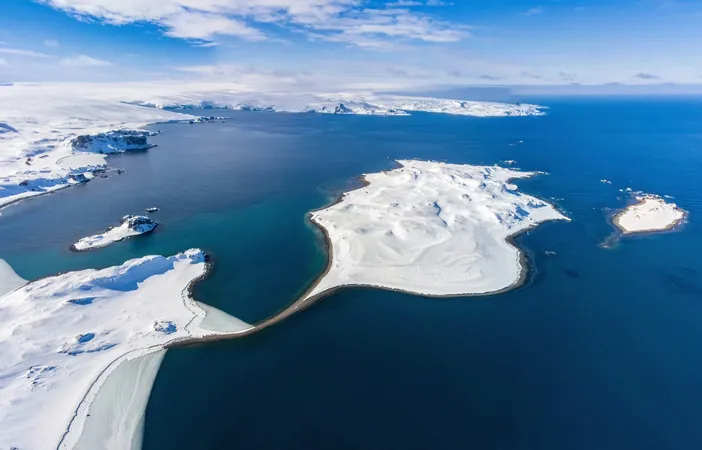
Unraveling the Carbon Storage Enigma in the Southern Ocean
2025-01-12
Author: Nur
A remarkable array of complexities surrounding carbon storage in the vast, deep seas is coming to light, as scientists delve into the intricate mechanisms governing our oceans. These immense underwater ecosystems are crucial for regulating Earth's climate, primarily driven by the actions of microscopic organisms.
A recent innovative study conducted by the UK's National Oceanography Centre (NOC) lends new insights into the pivotal role played by a unique group of microscopic algae, known as diatoms, in the natural storage of carbon in ocean waters.
The Role of Diatoms in Carbon Sequestration
Diatoms serve as significant players in carbon sequestration, particularly in the Southern Ocean, which accounts for about one-third of the world’s organic carbon stockpile. With their distinctive structured silica shells resembling tiny glass houses, diatoms have been thought to act as ballast, enabling them to sink into deeper waters and transport carbon along with them.
Dr. Sari Giering, Research Lead at NOC, emphasized the ocean's essential role in the global carbon cycle, stating, “Microscopic plants absorb billions of tons of carbon from the atmosphere every year. For years, we believed diatoms were crucial for efficiently barring carbon from returning to the atmosphere by transporting it to deeper ocean layers.”
New Insights on the Biological Carbon Pump
Traditionally, diatoms and other phytoplankton are understood to absorb carbon at the ocean's surface, a process known as the biological carbon pump, which then channels this carbon into deeper waters. However, novel findings from the NOC research suggest that diatom skeletons may not be sinking as deeply as previously thought. Instead, they tend to linger closer to the surface, while carbon continues its journey downward through other, yet to be identified mechanisms.
Dr. Giering remarked, “This revelation indicates that diatoms might not be contributing as significantly to the Southern Ocean’s carbon sequestration as we once presumed. There are numerous, unexplored processes occurring in the deep ocean that warrant further investigation.”
The Impact of Climate Change on Ocean Carbon Storage
As climate change looms large, concerns arise regarding the implications of warming oceans on diatom productivity and the overall efficiency of the biological carbon pump in the Southern Ocean. Yet, the latest research hints that these potential shifts may not drastically diminish the Southern Ocean's carbon storage capacity.
Jack Williams, a postgraduate researcher at the University of Southampton, stated, “While the Southern Ocean is indeed susceptible to warming, which could affect nutrient availability and diatom populations, our findings suggest the impact on carbon storage may be less severe than previously assumed.”
The Twilight Zone: A Critical Area of Research
An exciting frontier in this exploration is the "twilight zone," a mysterious mid-ocean layer extending from depths of 100 to 1,000 meters. Contrary to its ominous name, this region teems with life and intricate processes that are just beginning to be understood. Recent research indicates that a considerable portion of carbon sent to the depths comes from this layer, bypassing classic pathways linked to surface plankton like diatoms.
In the twilight zone, carbon is primarily transported by marine snow—aggregates of organic matter, dead plankton, and various detritus—which play crucial roles in how carbon descends to depths. Understanding the mechanisms at play in this vital area is paramount for accurately modeling climate dynamics and estimating the future performance of oceanic carbon storage.
Ongoing studies of the twilight zone may unlock the ocean's full carbon sequestration potential, ultimately informing new conservation strategies and shaping our efforts to combat climate change effectively.
For those interested in the intricate ballet of life and carbon in our oceans, these findings underscore the urgent need for deeper exploration and understanding of the vast underwater realms that protect our planet's climate.
 Brasil (PT)
Brasil (PT)
 Canada (EN)
Canada (EN)
 Chile (ES)
Chile (ES)
 Česko (CS)
Česko (CS)
 대한민국 (KO)
대한민국 (KO)
 España (ES)
España (ES)
 France (FR)
France (FR)
 Hong Kong (EN)
Hong Kong (EN)
 Italia (IT)
Italia (IT)
 日本 (JA)
日本 (JA)
 Magyarország (HU)
Magyarország (HU)
 Norge (NO)
Norge (NO)
 Polska (PL)
Polska (PL)
 Schweiz (DE)
Schweiz (DE)
 Singapore (EN)
Singapore (EN)
 Sverige (SV)
Sverige (SV)
 Suomi (FI)
Suomi (FI)
 Türkiye (TR)
Türkiye (TR)
 الإمارات العربية المتحدة (AR)
الإمارات العربية المتحدة (AR)